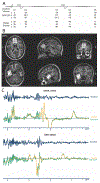Impact of gradient scheme and non-linear shimming on out-of-voxel echo artifacts in edited MRS
- PMID: 36196802
- PMCID: PMC9845189
- DOI: 10.1002/nbm.4839
Impact of gradient scheme and non-linear shimming on out-of-voxel echo artifacts in edited MRS
Abstract
Out-of-voxel (OOV) signals are common spurious echo artifacts in MRS. These signals often manifest in the spectrum as very strong "ripples," which interfere with spectral quantification by overlapping with targeted metabolite resonances. Dephasing optimization through coherence order pathway selection (DOTCOPS) gradient schemes are algorithmically optimized to suppress all potential alternative coherence transfer pathways (CTPs), and should suppress unwanted OOV echoes. In addition, second-order shimming uses non-linear gradient fields to maximize field homogeneity inside the voxel, which unfortunately increases the diversity of local gradient fields outside of the voxel. Given that strong local spatial B0 gradients can refocus unintended CTPs, it is possible that OOVs are less prevalent when only linear first-order shimming is applied. Here we compare the size of unwanted OOV signals in Hadamard-edited (HERMES) data acquired with either a local gradient scheme (which we refer to here as "Shared") or DOTCOPS, and with first- or second-order shimming. We collected data from 15 healthy volunteers in two brain regions (voxel size 30 × 26 × 26 mm3 ) from which it is challenging to acquire MRS data: medial prefrontal cortex and left temporal cortex. Characteristic OOV echoes were seen in both GABA- and GSH-edited spectra for both brain regions, gradient schemes, and shimming approaches. A linear mixed-effect model revealed a statistically significant difference in the average residual based on the gradient scheme in both GABA- (p < 0.001) and GSH-edited (p < 0.001) spectra: that is, the DOTCOPS gradient scheme resulted in smaller OOV artifacts compared with the Shared scheme. There were no significant differences in OOV artifacts associated with shimming method. Thus, these results suggest that the DOTCOPS gradient scheme for J-difference-edited PRESS acquisitions yields spectra with smaller OOV echo artifacts than the Shared gradient scheme implemented in a widely disseminated editing sequence.
Keywords: DOTCOPS; GABA; GSH; HERMES; coherence transfer pathway (CTP); out of voxel (OOV).
© 2022 John Wiley & Sons Ltd.
Figures




Similar articles
-
Gradient scheme optimization for PRESS-localized edited MRS using weighted pathway suppression.bioRxiv [Preprint]. 2025 Jul 18:2025.07.14.664705. doi: 10.1101/2025.07.14.664705. bioRxiv. 2025. PMID: 40791451 Free PMC article. Preprint.
-
Identifying out-of-voxel echoes in edited MRS with phase cycle inversion.bioRxiv [Preprint]. 2025 Jun 29:2025.06.26.661810. doi: 10.1101/2025.06.26.661810. bioRxiv. 2025. PMID: 40693601 Free PMC article. Preprint.
-
Prospective frequency and motion correction for edited 1H magnetic resonance spectroscopy.Neuroimage. 2021 Jun;233:117922. doi: 10.1016/j.neuroimage.2021.117922. Epub 2021 Mar 1. Neuroimage. 2021. PMID: 33662573
-
In vivo B0 field shimming methods for MRI at 7T.Neuroimage. 2018 Mar;168:71-87. doi: 10.1016/j.neuroimage.2017.06.013. Epub 2017 Jun 7. Neuroimage. 2018. PMID: 28602943 Free PMC article. Review.
-
B0 magnetic field homogeneity and shimming for in vivo magnetic resonance spectroscopy.Anal Biochem. 2017 Jul 15;529:17-29. doi: 10.1016/j.ab.2016.06.003. Epub 2016 Jun 9. Anal Biochem. 2017. PMID: 27293215 Free PMC article. Review.
Cited by
-
Application of a 1H brain MRS benchmark dataset to deep learning for out-of-voxel artifacts.Imaging Neurosci (Camb). 2023 Nov 2;1:imag-1-00025. doi: 10.1162/imag_a_00025. eCollection 2023. Imaging Neurosci (Camb). 2023. PMID: 40799723 Free PMC article.
-
Gradient scheme optimization for PRESS-localized edited MRS using weighted pathway suppression.bioRxiv [Preprint]. 2025 Jul 18:2025.07.14.664705. doi: 10.1101/2025.07.14.664705. bioRxiv. 2025. PMID: 40791451 Free PMC article. Preprint.
-
Brain glutathione and GABA+ levels in autistic children.Autism Res. 2024 Mar;17(3):512-528. doi: 10.1002/aur.3097. Epub 2024 Jan 26. Autism Res. 2024. PMID: 38279628 Free PMC article.
References
Publication types
MeSH terms
Substances
Grants and funding
LinkOut - more resources
Full Text Sources

